by Brian Fuller, Heritage Subcommittee Convenor, August 2021, from Bulletin 6/2021
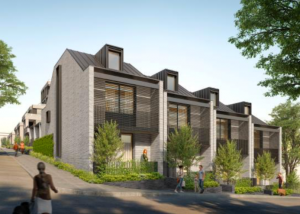
The Development Applications (DA) for the demolition of the Metropolitan Remand Centre (MRC) and construction of a seven-storey Residential Flat Building (RFB) along with seven two-storey terraces, all to the rear of Bidura House (357 Glebe Point Rd), are now on public exhibition for public comment.
In addition to the seven terrace dwellings (see Figure 1, above), the RFB footprint will contain 58 x one-, two- and three-bedroom apartment dwellings with ancillary landscaping located over a shared basement that comprises 72 car parking spaces. The wings of the RFB will be separated by a landscaped courtyard and reflection pool, with the two wings being re-connected at the upper level by a landscaped rooftop (see Figure 2 below). The development will also comprise a new pedestrian pathway link to Glebe Point Rd known as the Heritage Link. Minor conservation and repair works are proposed for Bidura House Group before it is on-sold as a single dwelling when the development is completed.
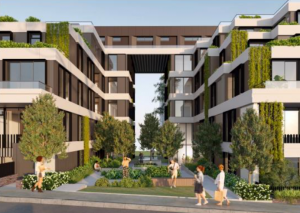
There are two DAs. The first DA, D/2017/582A, seeks a modification to the Concept DA approved by the Land and Environment Court (LEC) on 7 December 2018. Read the full DA at https://tinyurl.com/4apyyhh5. The second DA, D/2021/711, is for the proposal described above and can be read in full at https://tinyurl.com/5e2k3szb.
Bitter Sweet
The DA documentation confirms the intention of the owner, Vision Land Glebe Pty Ltd to undertake repairs and maintenance to the Bidura House Group. The gradual state of disrepair of the House in recent years has been obvious. Finally, there is confirmation that some repairs will be made. ‘Sweet’, yes; but the DA explicitly states that the House:
will be returned to a single residence. No new works are proposed to the house at this time or in this Detailed DA, except for modest conservation and maintenance works. These works largely comprise repairs to joinery, works to the roof, external and internal painting, stabilising the front fence until a new fence is built in the future, and a range of small works that will arise as other works take place. The intent of the works is to repair the house and hold it in a maintained condition until its sale and a future owner is secured. There are no changes proposed to the house that involve change to significant fabric. (Statement of Environmental Effects, p. 26)
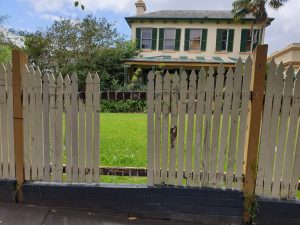
The commitment to ‘hold it in a maintained condition’ is something of a turnaround. Why only now? Sadly, and all too often, developers only commit to ‘maintain’ when seeking a DA because they know that Council has no real power to enforce commitments outside of the DA process. The Heritage Council has some powers under the Heritage Act 1977 but appears reluctant to enforce them.
‘Bitter’, in that execution day for the MRC is now one step closer. The proposed demolition of this Brutalist architectural building has been a controversial one within the community since the first DA (see Figure 4 below). Like it or not, some of the world’s most iconic architecture has attracted controversy; but that is the beauty of any form of artistic expression. Brutalism has attracted its fair share of global controversy, but future generations will undoubtedly revere it. For those who admire its bold and brash character, its preservation is as relevant as that of other periods of architectural expression. In this case, the MRC represents an important historical contribution to the social fabric of the Glebe community.

How did it get to this? Some history
The MRC was designed by NSW Department of Public Works architects John Whyte Thompson and Andy Milcz, as both fit for purpose accommodation for young offenders and two Children’s Courts. The MRC opened in May 1983. Changes in Government policy meant that for most of its life, the MRC functioned only as a Children’s Court, continuing to do so until its closure in 2017. Had the State Government not sold it to the current owner in 2014, it might well still be operating as a Children’s Court.
The MRC is not listed on the State Heritage Register nor locally listed on the City of Sydney LEP.
The first DA on this site, DA2015/1398, was refused by the City of Sydney and then by the LEC in October 2016, following an appeal by Vision Land. In 2017, the City of Sydney refused the subsequent DA, DA2017/582, and again Vision Land appealed to the LEC, this time with success. The City of Sydney subsequently, but unsuccessfully, appealed against the findings of the LEC.
It is important to record that the current LEP came into effect in 2012. One cannot fail to note that during its ownership, the then State Government, via its Department of Planning, issued a Certificate pursuant to Section 65 of the Environmental Protection Act requiring the draft LEP to be issued with a height control of 27 m over most of the site and 9 m over the remainder. Before this time, the whole site had a 9 m height control over it.
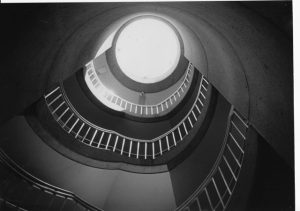
The City pushed back, seeking a compromise at 18 m, but was refused when the State Government determined that the 27 m height control should prevail over most of the site. The 27 m height control was included within the 2012 LEP, which came into force in December of that year.
The site was then offered for sale by public tender and purchased by Vision Land in 2014. Instead of acting in the public interest, the State Government afforded itself a financial advantage with the stroke of a pen. It took the money and ran.
The State Government could have looked at its forward projections for affordable and social housing. It already had a crisis in the supply of public housing. The state government should have instructed its Department of Planning to develop a Plan to consider the matrix of Government-owned land that could contribute to the immediate supply of public housing.
We now have a site that is to be allocated to private housing and a current State Government running around spot rezoning other sites in Glebe to get itself out of a crisis that has been left burning for too many years. We know there will be more spot rezoning to come.
The Current Status
Vision Land appealed the decision of the City of Sydney to reject the DA D/2017/582, and on 7 December 2018, the LEC found in favour of Vision Land. The rationale for some of the findings so concerned the City that it appealed before a different LEC Commissioner. The appeal was unsuccessful. The final orders of the LEC on 7 December 2018 were:
- The appeal is upheld;
- Concept Development Application No. D/2017/582 for building envelopes for a residential development to accommodate a 6-storey residential apartment building with a two-level basement, and 8 x two-storey plus attic dwellings, including the retention of the Bidura House Group, demolition of the MRC, and associated site works including tree removal is approved, in accordance with the amended plans and conditions as set out in Annexure A.
- The exhibits are to be returned, with the exception of Exhibits A, 3, 16 and 18.
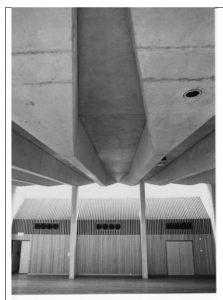
HeritageAssessment.pdf)
The contents of Annexure A include, but are not limited to, the following:
(4) Building Height: The height of any future building, including services, must not exceed the maximum levels set out in the approved building envelopes.
(4a) Building Setbacks: The setbacks of any future building, must not be less than that shown on the approved building envelope plans.
(5) Design Competition: A competitive design process in accordance with the provisions of Sydney LEP 2012 and Sydney DCP 2012, and approved ‘Design Excellence Strategy’ prepared by Mecone and submitted on 28 February 2018 shall be conducted prior to the lodgement of a detailed Development Application.
(6) Public Art: A Detailed Public Art Plan is to be developed for the development in accordance with the City of Sydney’s Public Art in Private Developments Guidelines and the City of Sydney’s Public Art Policy and submitted with any subsequent detailed Development Application.
(a) The Public Art Strategy must, among other things: (i) set out the intended budget for public art; (ii) identify how decisions will be made; (iii) detail the proposed method for integrating the public art process with the competitive design process; and (iv) detail the proposed method for integrating the public art process with the construction of all proposed development on the site.
(b) Neither street furniture nor interpretation strategy be considered as part of the public art component.
(c) The Public Art Strategy must be approved by the Director City Planning Development & Transport prior to the competitive design process and must be lodged with the relevant future detailed development applications.
(7) Heritage Interpretation Plan
- A heritage interpretation plan for the site must be provided with any subsequent detailed development application.
- The heritage interpretation plan must detail how information on the history and significance of the site will be provided for future occupants of the site and general public, and make recommendations regarding public accessibility, signage and lighting. Note: Public art, details of the heritage design, and the display of selected artefacts are some of the means that can be used.
- The heritage interpretation plan must specifically address the history and significance of the Bidura House Group as well as the use of the site for the Depot for State Children and the Metropolitan Girls’ Shelter (1920-1977) and the Metropolitan Remand Centre (1980-2017).
- The heritage interpretation plan must provide the location, type, materials and contents of the interpretation proposed, and this is to be prepared by a suitably qualified and experienced heritage practitioner/historian.
- The heritage interpretation plan must include the staging of the implementation of the interpretation, as it relates to any staging of the development.
(9) Conservation Works to the Bidura House Group
- A Schedule of Conservation works for the Bidura House Group, including Bidura House, the annex and ballroom, supported by drawings and, where necessary, specifications is to be prepared and implemented as part of any future development proposal that relates to the Bidura House
- The schedule is to be prepared in accordance with the recommendations of the Conservation Management Plan prepared for the site by GBA in September 2015 by a suitably qualified and experienced heritage consultant.
Bidura House is listed on the State Heritage Register (SHR 01994); therefore, any works to the item are subject to Section 60 of the Heritage Act 1977. It is also listed on the City of Sydney LEP as item no 1763. The listings include the house and interiors, the ballroom and curtilage, which together make up the Bidura House Group.
There have now been two Concept DAs. Both have been refused by the City of Sydney. Further, three appeals to the LEC have been made. The collective outcome is that Vision Land is in a position to lodge this DA on the basis that it adheres to the LEC’s conditions issued on 7 December 2018. To put it bluntly, the Court has effectively determined that the development will proceed, notwithstanding the public’s right to comment on, or object to, the DA as submitted.
With regard to DA D/2017/582A, Vision Land is seeking what is known as a Section 4.56 amendment to the conditions in Annexure A, claiming its amendments are as a result of the design competition and the detailed design process, and that these amendments will not have a significant impact on the overall development envelope.
Where to from here?
The public has the opportunity to lodge submissions in response to both DAs. Any submission on DA D/2021/2017 must be lodged by 6 August, and submissions on DA D/2017/582A must be lodged by 11 August.
While the development will proceed (subject to economic conditions), there is still the opportunity to influence the finer details, construction management practices and the protection of the heritage-listed Bidura House Group. The Glebe Society will lodge its submission(s) on the DAs to the City of Sydney. We will also consider making a submission to the Heritage Council of NSW in relation to Vision Land’s Integrated Development Application pursuant to the Heritage Act 1977.
The Glebe Society’s submission will address the following:
- Adherence to the approved building envelope and the degree of reasonableness (or otherwise) of the Section 4.56 variation. We note that the approved Concept DA plan is for a six-storey apartment building whereas this DA is for a seven-storey apartment building. We also note that the detailed design has created a lower ground level on the northern side which is one of the seven storeys.
- Traffic and noise management during the construction program.
- The requirement for Vision Land to undertake appropriate repairs and maintenance of the Bidura House Group, including any required by the NSW Heritage Council.
- The requirement for Vision Land and its successors to maintain the Bidura House Group in a state of good repair and maintenance after the DA is approved and until sold, no matter when that happens.
- The implementation of the Heritage Interpretation Plan.
- The implementation of the Public Art Plan.
- Any other issues that may surface.
This has been a long process, and many people within the community have fought very hard to save the MRC. Without doubt, the State Government has acted against the public interest by firstly, changing the permitted height for most of this site to 27 m, and secondly, selling the site for private housing alone.
To ensure the long term and rightful protection of the Bidura House Group, an appropriately revised Heritage Act with an empowered Heritage Council and City of Sydney is a must.
[Have you been inside the Metropolitan Remand Centre? If so, let us know what you thought of it! Email editor@glebesociety.org.au]
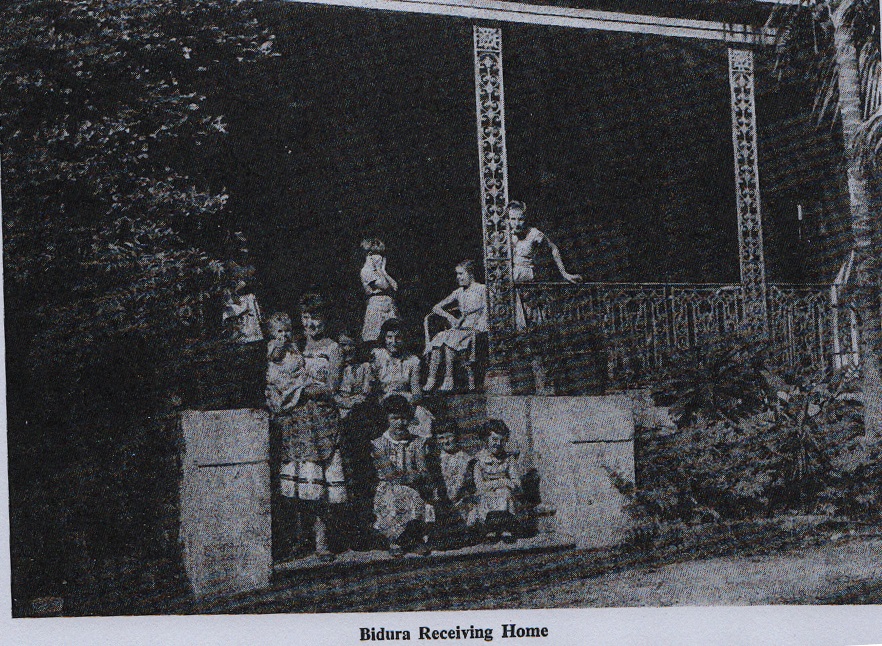










There are no comments yet. Please leave yours.